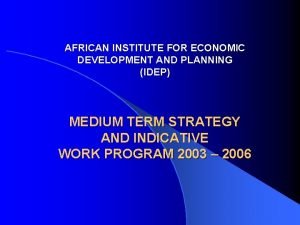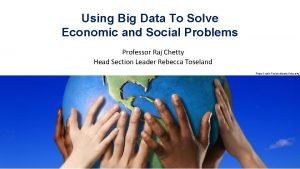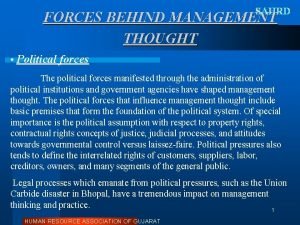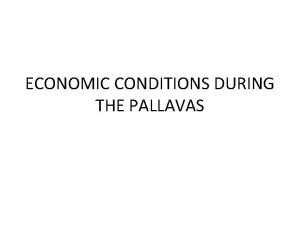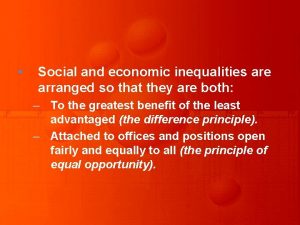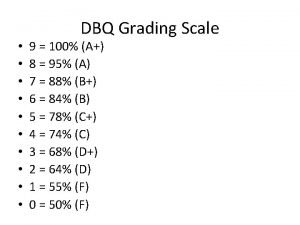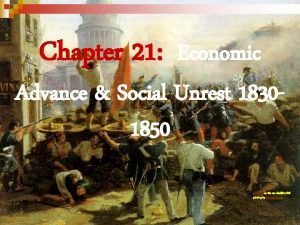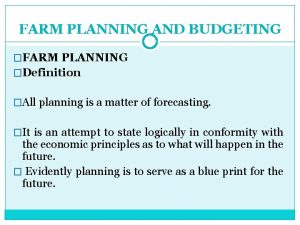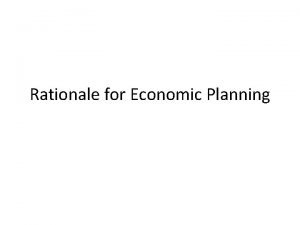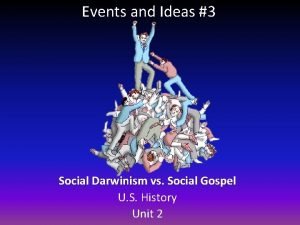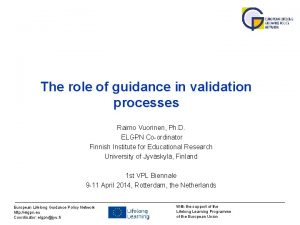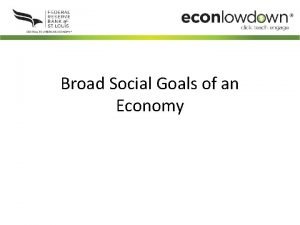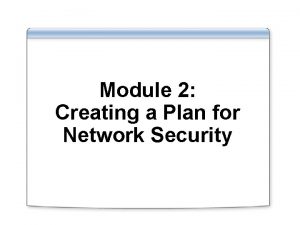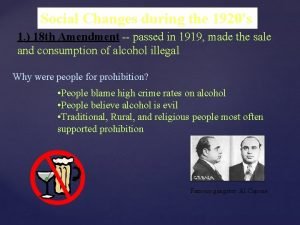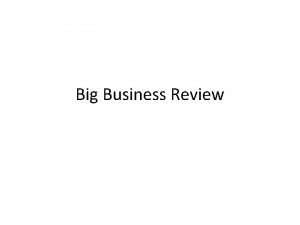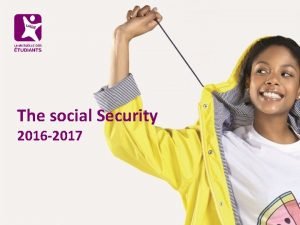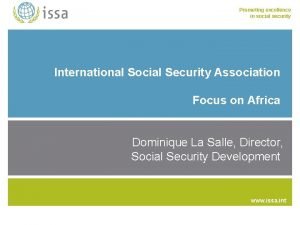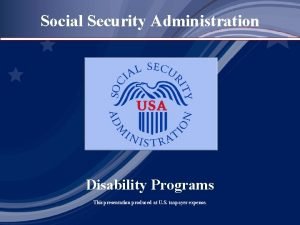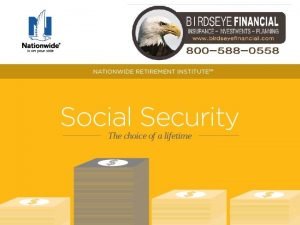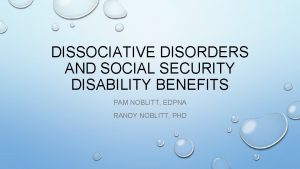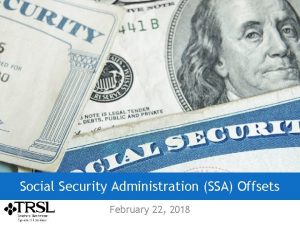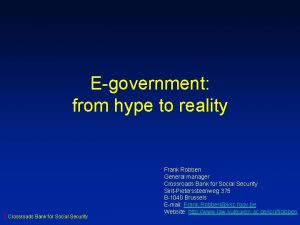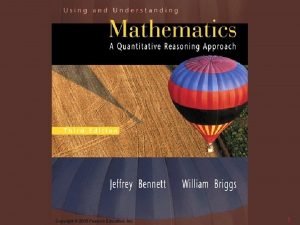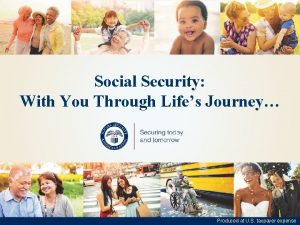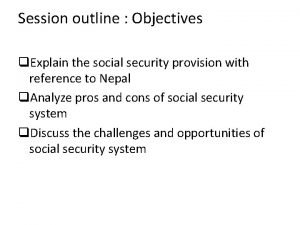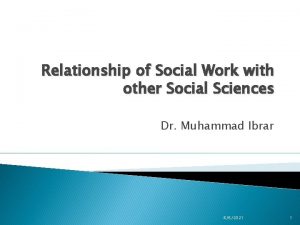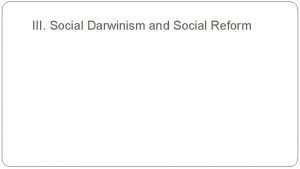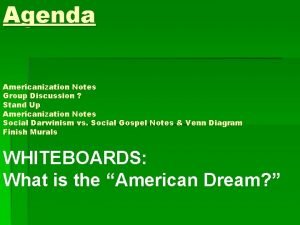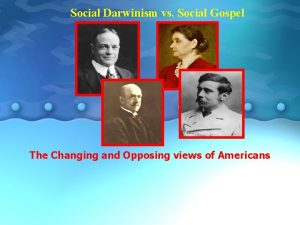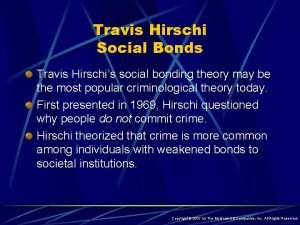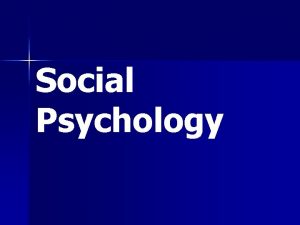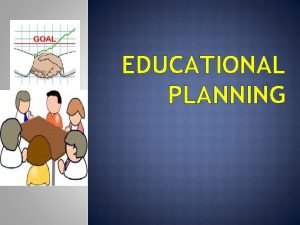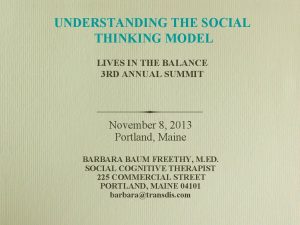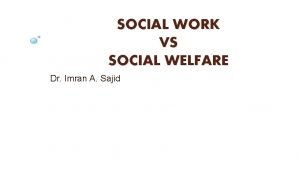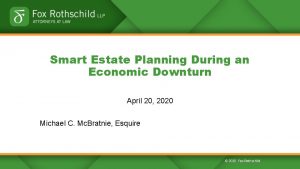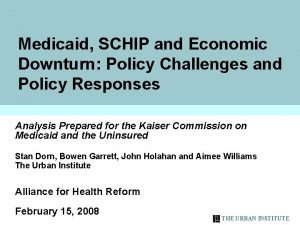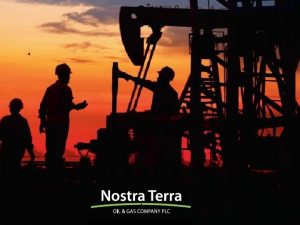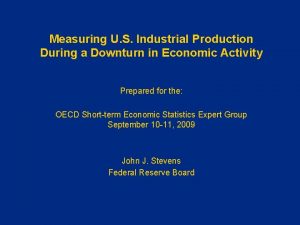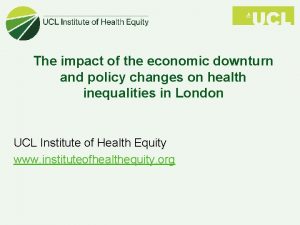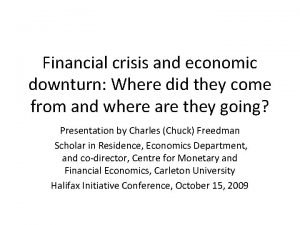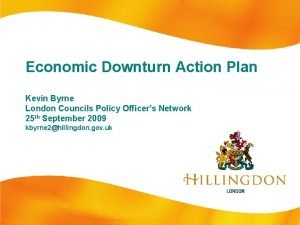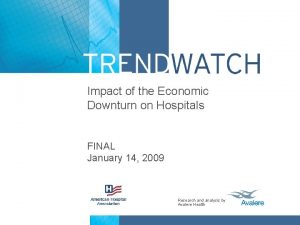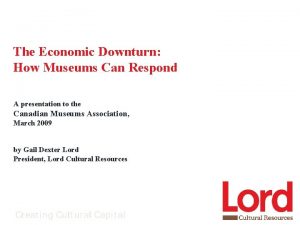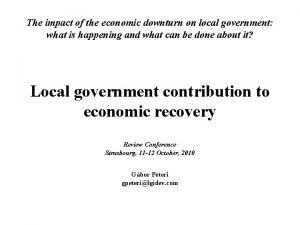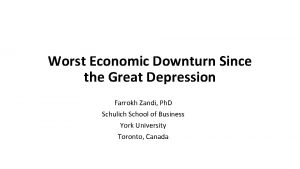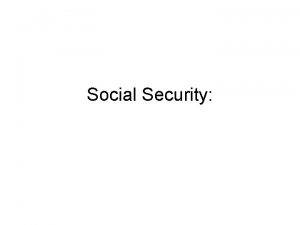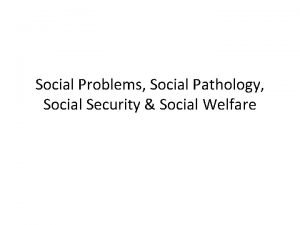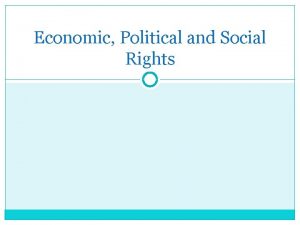Social security planning during an economic downturn and

































































- Slides: 65

Social security planning during an economic downturn and other issues • Wayne Belford • ING Australia

Agenda • Bonuses announced 3 February 2009 • Change in definition of “partner” • Proposed income assessment changes • • Adjusted taxable income • Super salary sacrifice Reviewing social security entitlements in a decreasing market • • • Fa. HCSIA valuation of managed funds and shares Entitlement to social security income support after a redundancy • Waiting periods • Activity test Voluntarily paying a higher accommodation bond to increase social security entitlement 2

Bonuses 3

How good can it be? • Couple, Peter and Susan • Sue earns $60, 000 in 2007/08 • Peter works part time and earns $15, 000 in 2007/08 • 3 children • Eva – 17 years old • Zoe – 13 years old • Bob – 6 years old 4

How good can it be? Sue’s Tax bonus $950 + Back 2 School - Eva $950 + + Pete’s Tax bonus $950 Back 2 School - Zoe $950 + + $5, 700 tax free! 5 Single Income Bonus $950 Back 2 School - Bob $950

Tax bonus Conditions • Must be Australian resident taxpayer • Must enter tax 2007/08 return by 30 June 2009 (or have dispensation) • Must have a net tax liability in 2007/08 • Must have taxable income of less than or equal to $100, 000 in 2007/08 • If under 18, must be excepted individual or have excepted income 6

Net tax liability Net tax payable plus Medicare levy surcharge less Tax offsets include franking credits but exclude Family Tax Benefits 7

Tax bonus • No application necessary • Payments commence from April 2009 • Bonus is non-assessable non-exempt income • Bonus is not assessable as income for Centrelink or DVA benefits 8

Case study - Doris • Doris (80) receives the age pension • Doris’ only other assessable income is $3, 000 from a small term deposit • Will Doris qualify for the tax bonus? No, the low income tax offset and senior Australians’ tax offset will combine to give her no net tax liability. 9

Case study - Dianne • Dianne (62) is a sole trader who owns a book store • In 2007/08 Dianne had income from her business of $48, 000 and deductions of $10, 000 • Dianne also had income from a share portfolio of $5, 000 (fully franked) • Dianne has made personal contributions for which a deduction of $20, 000 has been claimed (bringing her taxable income to $25, 143) 10

Case study - Dianne Tax payable $2, 871 Medicare levy + surcharge $377 Offsets (including credits) $3, 393 Net tax liability ($145) Dianne has no net tax liability and hence receives no Tax bonus 11

Case study - Dianne What if Dianne claimed $1, 000 less in deductions on personal contributions? (variation notice) Tax payable $3, 021 Medicare levy + surcharge $392 Offsets (including credits) $3, 393 Net tax liability $20 She now qualifies but was it worth it? 12

Case study - Dianne Additional tax paid $150 Additional Medicare levy $15 Reduced offsets $0 Reduced contributions tax $150 Dianne has paid an extra $15 in tax to receive the $950 bonus 13

Case study - Jim • Jim (45) qualifies for the full ($950) tax bonus • Jim’s income is likely to be around $30, 000 in 2008/09 (all employment income) • Jim uses his bonus to make a personal contribution to super Bonus amount $950 Co-contribution $1, 425 Total benefit $2, 375 14

Single Income Family bonus Conditions • Must qualify for Family Tax Benefit (FTB) Part B for the period including 3 February 2009 • Available to those who receive FTB Part B periodically or in a lump sum 15

Single Income Family bonus • Payments commence from 11 March 2009 (for periodical FTB Part B beneficiaries) • Bonus is exempt income (i. e. tax free) • Bonus is not assessable as income for Centrelink or DVA benefits • Bonus is a flat rate of $950 16

Case study – Roger and Mary • Roger (42) and Mary (38) have one child, Sharon (6) • In 2008/09, Roger’s only income will be his salary ($165, 000) • Mary earns $10, 000 per annum from investments Roger and Mary would be excluded from receiving FTB Part B as Roger’s income is above $150, 000 But… 17

Case study – Roger and Mary • Roger implements a salary sacrifice arrangement in February which reduces his income to $145, 000 for 2008/09 • Mary claims FTB Part B in late 2009 after she and Roger enter their 2008/09 tax returns Provided they hadn’t made a previous claim for the same period and met the Family Assistance Office rules for making a claim for a previous period, Mary will now receive approx $1, 580 in FTB Part B plus $950 as the Single Income Family bonus for the 2008/09 year Note - Subject to proposed changes in the income definition 18

Back to School bonus Conditions • Must qualify for Family Tax Benefit (FTB) Part A for the period including 3 February 2009 • Available to those who receive FTB Part B periodically or in a lump sum • Those aged under 19 on 3 February 2009 in receipt of the Disability Support Pension (DSP) or Carer Payment (CP) also qualify 19

Back to School bonus Payments • $950 payable for each child aged 4 -18 (inclusive) used to calculate the rate of FBT Part A for the period including 3 February 2009 • $950 payable to each individual aged under 19 on 3 February who is in receipt of the DSP or CP • Only one back to school bonus payable in respect of each individual 20

Back to School bonus • Payments commence from 11 March 2009 (for periodical FTB Part B beneficiaries) • Bonus is exempt income (i. e. tax free) • Bonus is not assessable as income for Centrelink or DVA benefits 21

Case study – Christine • Christine (42) is a single mother who works full time • Christine has two children, Charlie (12) and Betty (9) • Christine will earn $120, 000 in 2008/09 from her job as a accountant • Christine has no other income Christine would be ineligible for FTB Part A as her adjusted taxable income exceeds her cut-out threshold of $111, 082 However… 22

Case study – Christine • Christine implements a salary sacrifice arrangement in February which reduces her income to $105, 000 for 2008/09 • Christine claims FTB Part A in late 2009 after she enters her 2008/09 tax return Provided she hadn’t made a previous claim for the same period and met the Family Assistance Office rules for making a claim for a previous period, Christine will now receive approx $1, 820 in FTB Part A plus $1, 900 in Back to School bonuses Note - Subject to proposed changes in the income definition 23

Training and Learning bonus Conditions • Must qualify for a designated payment for the period including 3 February 2009 • If an individual is used to qualify for a Back to School bonus they will not receive a Training and Learning bonus 24

Training and Learning bonus Payments • Flat rate of $950 person • Bonus is tax exempt (i. e. tax free) • Bonus is not assessable as income for Centrelink of DVA benefits 25

Training and Learning bonus (eligible payments) • Youth allowance (only FT students and apprentices) • Austudy • ABSTUDY (if incl living allowance) • An education allowance under • the Veterans’ Children Education Scheme; or • the Military Rehabilitation and Compensation Act Education and Training Scheme • FTB Part A (for each eligible, FT student dependant aged 2124) • Sickness Allowance • Special Benefit (if recipient under pension age at 14 October 2008) 26

Increased Education Entry Payment Conditions • Those eligible for an Education Entry Payment (Ed. EP) between 1 January 2009 and 30 June 2010 will receive an additional $950 • Ed. EP is available (if eligible training is undertaken) to a range of income support payment recipients The increased Ed. EP is exempt from tax (i. e. it is tax free) and not assessable as income for Centrelink or DVA benefits 27

Administrative scheme Provisions were included to allow a new scheme to be created should the existing bonuses not fully achieve their goals Example – payments for those who have FTB children aged 19 or 20 who study full time 28

Change in definition of “partner” 29

Change in definition of “partner” • From 1 July 2009, the definition of “partner” will include persons of the same sex as well as persons of the opposite sex. • Will affect all current and new Centrelink and DVA recipients • Will generally result in a reduction in payment amount for income support recipients • (i. e. couple rate is less than two single rates) 30

Proposed income assessment changes 31

Proposed income assessment changes • New definition of adjusted taxable income (ATI) affects Commonwealth Seniors Health Card (CSHC) holders and Family Tax Benefits • • From 1 July 2009, ATI will also include • income from income streams and lump withdrawals from super (from a taxed source) if over the age of 60 and • Super salary sacrificed amounts will be added back to income for all income support recipients • Currently excluded if under age pension age 32

Example Ron holds a CSHC at the start of 2009/2010. He is drawing down $20, 000 pa from an allocated pension which consists of 100% tax-free component. He also intends to withdraw a lump sum of $10, 000 from an existing super fund in the same financial year Under the current rules, the above amounts would have been ignored for the purpose of assessing the CSHC From 1 July 2009, the $20, 000 will be included in Ron’s ATI. An additional $10, 000 will be added to his ATI when he withdraws the lump sum. 33

Industry proposals 1. Align the current social security income test rules for income streams • 2. i. e. allow a deductible amount based on purchase price and relevant number (term or life expectancy) OR Calculate the tax-free amount of an income stream according to the components. • This is the less favoured proposal as it is likely to be complex to administer No industry proposals regarding lump sum withdrawals and salary sacrifice 34

Alternatives? • Should proposals become law, consider combination super/non-super investments • No tax payable using SATO • $25, 867 pa income for singles • $37, 950 pa income for couples 35

Case study • Martin is a single CSHC holder • • Requires income of $55, 000 pa • • Does not receive age pension due to assets Currently not paying tax Allocated pension - $600, 000 balance • Annual payment $45, 000 • Other assessable income $10, 000 • 2008/09 assessable amount is • • $10, 000 Martin retains CSHC until 30 June 2009 From 1 July 2009 assessable amount will be $55, 000 so Martin will lose CSHC 36

Case study • Consider withdrawal of $300, 000 prior to 1 July 2009 • Allocated pension - $280, 000* balance $14, 000 Annual payment (min) Other assessable income $10, 000 Bank account $300, 000 at 6% $18, 000 Assessable amount for CSHC $42, 000 Withdraw from bank account to make up additional requirements • Tax assessable amount $28, 000 • No tax payable * Balance allows for earnings and minimum annual payment during 2008/09 37

Reviewing social security entitlements in a decreasing market 38

Re-assessment of social security entitlement • Generally two updates per year for shares & managed funds • Extra-ordinary update 3 November 2008 to reflect market values on 13 October 2008 • (i. e. after large share market falls in first half of October) • Client may still request additional update(s) at any time 39

Timing the claim or application for re-assessment • Client(s) may have applied for: • income support due to drop in value of investments but claim was rejected; or • a re-assessment of existing income support but little, if anything, changed • Share values are received by Fa. HCSIA every two weeks • Managed fund values (unit priced) are received every 4 weeks • Consequently, values may be up to 6 weeks old at the time of requesting a review 40

Timing the claim or application for re-assessment • What action can client take? • Check with Centrelink or DVA when last re-valuation of their data base occurred and when next update is due • May then be worth submitting new claim or new reassessment request 41

Centrelink and frozen funds • Frozen funds • Fund may continue to pay income only; or • Both income and asset are frozen 42

Centrelink and frozen funds • Centrelink will continue to assess both categories under the income and assets test • To have funds excluded, client would need to satisfy the Hardship Provisions • Pension Loan Scheme available for part-rate pensioners • Generally, company would need to have ‘failed’ (e. g. appointment of a receiver or administrator) for the investment to be disregarded • Current frozen mortgage funds not in this category 43

Hardship Provisions v Pension Loan Scheme Hardship PLS • No age criteria • Must be of age pension age or over • Cannot get income support or gets reduced amount due to assets test but would have qualified under the income test • Cannot get pension or gets reduced amount due to income or assets test • Asset cannot be sold or borrowed against • Must have Australian real estate as security • Gifting provisions have not been triggered • Loan establishment costs payable by applicant • Person is in “severe financial hardship” • Compounding interest will be charged fortnightly (5. 25% pa) • Payment is calculated using special formula – max amount is max pension rate • PLS pays an amount up to the maximum rate of pension + PA + RA 44

Hardship provisions • Definition of “severe financial hardship” • The person’s total fortnightly income (inc. pension) is less than max rate pension or allowance • Readily available funds less than allowable limit • Includes Age Pension, DSP, Carer, Austudy • Single $14, 614. 50 • Couple $24, 414. 00 • Includes NSA, Parenting Payment, Widow Allowance • Single $6, 000 • Couple $10, 000 • There are no other options to improve financial situation 45

Entitlement to social security payments after redundancy or re-entering the workforce 46

Entitlement to social security payments after redundancy or re-entering the workforce • Under Age Pension age, Newstart Allowance is the primary payment (unless disability exists) • No more partner payments so Newstart is generally only option for partner 47

Does the person need to serve a waiting period? • Ordinary waiting period • If re-entering workforce, (generally) only the “ordinary waiting period” will apply • One week from time of claim • Applies to allowances only • Liquid assets waiting period • Applies from termination of employment • Max 13 weeks • Applies to NSA, SA YA and Austudy 48

Income maintenance period • Not technically a waiting period but usually acts as one • Applies to Newstart, Widow’s Allowance, Youth Allowance, Sickness Allowance, Austudy, Disability Support Pension, Parenting Payment • Applies from time of payment with no cap • May be served concurrently with LAWP • Based on lump sum termination payments • Leave payments, rostered days off, ETPs, tax-free amounts 49

Example • Colin (single) received the following termination payments: • Annual leave : 5 weeks @ $1, 000 pw • Long Service : 13 weeks @ $1, 000 pw • Tax-free amount : $20, 000 • ETP : $15, 000 • Colin has no other investments 50

Calculating the waiting period 1. Ordinary waiting period is 1 week 2. Calculate LAWP • Total liquid assets = $53, 000 • LAWP = ($53, 000 -$2, 500)/$500 = 101 weeks • However, max is 13 weeks – applies from date of termination • OWP + LAWP = 14 weeks 51

Calculating the waiting period 3. Calculate the IMP • Annual & long service leave is 18 weeks • Tax-free payment $20, 000/1000 = 20 weeks • ETP : $15, 000/1000 = 15 • Total IMP is 53 weeks • Applies from the date the termination payments were made and may be served concurrently with LAWP 52

Entitlement to social security payments after redundancy or re-entering the workforce • Activity test will apply for Newstart Allowance • Actively seeking & willing to undertake suitable work • In some cases, a partial capacity to work will apply if there is an medical incapacity • Age 55 or more • Can satisfy activity test by undertaking at least 30 hours per fortnight of voluntary work, paid work or combination of the two • Exemptions for • people with unexpected caring responsibilities • temporarily incapacitated • major personal crisis 53

Self-employed • Newstart allowance is not usually available to the self-employed as a “top-up” when earnings are down • Would need to satisfy Centrelink that they are still available for other work and able to satisfy the activity test 54

Paying a larger accommodation bond in exchange for lower fees 55

Paying a larger accommodation bond • Technically most aged care fees and charges are negotiable • Published amounts are maximums only • Some hostels may consider accepting a larger accommodation bond in exchange for lower fees • Common example is a reduction or waiving of the retention amount 56

Case study • Ron - single, non-homeowner, age pensioner • Entering hostel – standard bond is $250, 000 • Assets • Bank accounts $500, 000 • Managed funds $ 90, 000 • Personal effects $ 10, 000 • Total $600, 000 • Current age pension $112. 48 pf ($2, 924 pa) 57

Case study • After paying $250, 000 bond, assets will be: • Bank accounts $250, 000 • Managed funds $ 90, 000 • Personal effects $ 10, 000 • Total $350, 000 • Age pension rate increases to $420. 40 pf ($10, 930 pa) 58

Case study • Hostel willing to waive the retention amount in full • $3, 504 pa for a maximum of 5 years • Total savings possible is $17, 520 • Larger bond of $325, 000 will be payable • i. e. an extra $75, 000 • After paying $325, 000 bond, assets will be: • Bank accounts $170, 000 • Managed funds $ 90, 000 • Personal effects $ 10, 000 • Total $275, 000 • Age pension rate increases to $469. 60 pf ($12, 210 pa) • (i. e. $1, 280 pa more) 59

Case study - Summary • Total savings/benefit in the first year • $1, 280 + $3, 504 = $5, 104 • Ron would be losing potential interest on the $75, 000 • Say $75, 000 @ 4% = $3, 000 pa • Ron is potentially better off by $2, 104 pa • This would be greater if interest rates further decrease (or vice versa) • “Full” bond is refunded to client on leaving or to estate on death 60

Online technical support 61

Online technical support • Technical Update 2009/02 – 2009 Government stimulus package • Technical Bulletin 41 – Tax offsets • Links: • “Australian Guide to Government Payments” • “Family Assistance: Guide to Payments” • Information on Family Tax Benefit qualification and payment • Tax and Other Facts 62

Accessing the technical support library 63

Accessing technical support material 64

Disclaimer This information is a summary based on ING’s understanding of the relevant legislation. It is general in nature and may not be relevant to individual circumstances. You should not do or refrain from doing anything in reliance on this information without obtaining suitable professional advice. 65
 Private securit
Private securit Growth and development conclusion
Growth and development conclusion Economic growth vs economic development
Economic growth vs economic development Lesson 2 our economic choices
Lesson 2 our economic choices African institute for economic development and planning
African institute for economic development and planning Apa itu social thinking
Apa itu social thinking Social thinking social influence social relations
Social thinking social influence social relations Wireless security in cryptography
Wireless security in cryptography Electronic commerce security
Electronic commerce security Using big data to solve economic and social problems
Using big data to solve economic and social problems Various forces behind management thought
Various forces behind management thought Social and economic condition of pallavas
Social and economic condition of pallavas Social and economic inequalities are to be arranged
Social and economic inequalities are to be arranged Dbq grading scale
Dbq grading scale Giuseppe mazzini
Giuseppe mazzini Importance of physical farm planning
Importance of physical farm planning What are the rationale of economic planning
What are the rationale of economic planning Proactive planning and reactive planning
Proactive planning and reactive planning Short medium and long term planning in education
Short medium and long term planning in education Language policy in pakistan slideshare
Language policy in pakistan slideshare Osi security architecture in network security
Osi security architecture in network security Security guide to network security fundamentals
Security guide to network security fundamentals Visa international security model
Visa international security model Electronic mail security in network security
Electronic mail security in network security Nstissc model
Nstissc model Software security touchpoints
Software security touchpoints Security guide to network security fundamentals
Security guide to network security fundamentals Security guide to network security fundamentals
Security guide to network security fundamentals Social darwinism vs social gospel
Social darwinism vs social gospel Economic social development
Economic social development Political economic
Political economic Economic social development
Economic social development Broad social economic goal examples
Broad social economic goal examples Planning phase for network security design
Planning phase for network security design 1920s social changes
1920s social changes Industrialists of the late 1800s used pools and trusts to
Industrialists of the late 1800s used pools and trusts to Strategic planning vs tactical planning
Strategic planning vs tactical planning Planning balance sheet in urban planning
Planning balance sheet in urban planning Role segmentation workforce planning
Role segmentation workforce planning Perencanaan agregat
Perencanaan agregat Aggregate planning is capacity planning for
Aggregate planning is capacity planning for Aggregate planning is capacity planning for
Aggregate planning is capacity planning for Social security card france
Social security card france Excellence in social security
Excellence in social security Minimum social security benefit
Minimum social security benefit 18003250778
18003250778 Lao social security organization
Lao social security organization Nationwide social security 360 analyzer
Nationwide social security 360 analyzer Dissociative identity disorder social security disability
Dissociative identity disorder social security disability Social security office
Social security office Crossroads bank for social security
Crossroads bank for social security Social security
Social security Myaccount.social security.gov
Myaccount.social security.gov Objective of social security
Objective of social security Difference between social action and social interaction pdf
Difference between social action and social interaction pdf Social work relationship with other social sciences
Social work relationship with other social sciences Social thinking and social influence
Social thinking and social influence Lesson 3 social darwinism and social reform
Lesson 3 social darwinism and social reform Social darwinism and social gospel venn diagram
Social darwinism and social gospel venn diagram Social gospel vs social darwinism
Social gospel vs social darwinism Global agenda for social work and social development
Global agenda for social work and social development Hirschi bonds of attachment
Hirschi bonds of attachment Social thinking theory
Social thinking theory Characteristics of educational planning
Characteristics of educational planning Double interview michelle garcia winner
Double interview michelle garcia winner Social welfare vs social work
Social welfare vs social work




